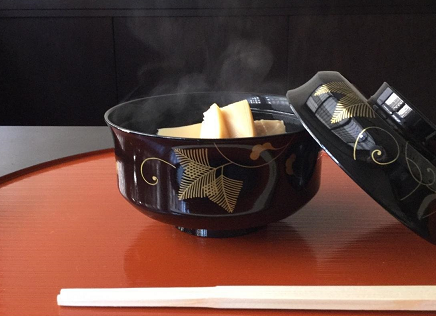料理店にとって酒造業と同じく水はとても大切です。 出汁を取ったり、煮炊きや食材の水洗いに、当店は自家の井戸水を使っています。 京都盆地は地下水の上に浮かぶお盆に譬えられるほど、地下水脈が豊富です。その水質は鉱物質の少ない軟水で、昆布や鰹節と相性が良く旨味を引き出します。 そのまま飲んでも、珈琲や緑茶を淹れても、水道水と比べてみれば違いがわかります。 この地下水は京都市南部伏見に集まり、桃山丘陵の地下水とも混ざり合い、伏見の各酒造メーカーの清酒仕込水になります。
当店が出汁を取る水も同じ水質の水なので、伏見の清酒との相性が良いのはそのためです。
Dashi the soup stock at the heart of Kyoto cuisine Just like in sake brewing,
water is extremely important for a restaurant. At our establishment, we
use water drawn from our own well for making dashi, simmering and boiling
dishes, and washing ingredients. The Kyoto Basin is often likened to a
tray floating on underground water due to its abundant aquifers. The water
here is soft, low in mineral content, and pairs perfectly with kombu and
dried bonito, bringing out their umami.
You can even taste the difference compared to tap water—whether you drink
it as is or use it to brew coffee or green tea. This underground water
gathers in Fushimi, in the southern part of Kyoto City, where it mixes
with the waters from the Momoyama Hills.
It then becomes the brewing water for many sake producers in Fushimi.
Because the water we use for dashi has the same quality, it naturally pairs
well with Fushimi’s sake.

当店が数回開催しています「日本料理味覚伝承プロジェクト」は子供たちの記憶に、日本伝統の味を刻み込もうとする試みです。
簡易食があふれる社会で、ささやかな抵抗ですが、参加した子供さん達が、京料理の味に感動されるのを見て、逆にこちらが感動させられた経験からはじめたものです。一度でも、数回でも本物に触れていただくことで、味覚の記憶に日本の味を刷り込めるのではないかと考えています。
大人ひとり(正規料金)につき小中高校生おひとり(¥1,100-)です。

日本国土にしめる森林面積は66%もあり、森林大国であることが料理素材としての魚介類を育てています。
森から川となって海へ流れ込む栄養分が川魚や海藻やプランクトンを育て、近海漁業の魚種・魚量を豊富なものにしています。
当店では出汁を取る昆布は北海道・利尻、礼文産を使っています。
昆布店の店主から「流氷の多い年は、生育の良い昆布が獲れる」と聞きました。
ロシア・アムール河で氷結した氷が、流氷になって栄養分を運んでくるのだそうです。森林の栄養分が海の魚を育てるのと同じことのようです。
森林が光合成によって二酸化炭素を吸収し、酸素を放出するように、海の藻場に生える昆布やワカメも、水中で二酸化炭素を吸収し、酸素を放出していることが最近わかってきました。森林のグリーン・カーボンに対してブルー・カーボンと呼ばれて注目されています。
南北に伸びる日本列島は寒暖の差が大きく、明確な四季を形成します。日本料理の野菜や薬味は四季のおかげで、多種多様さを誇っています。
このように生態系、自然と共生することが日本の伝統であり、京料理はその精神を大切にすることが、その命脈となっております。
